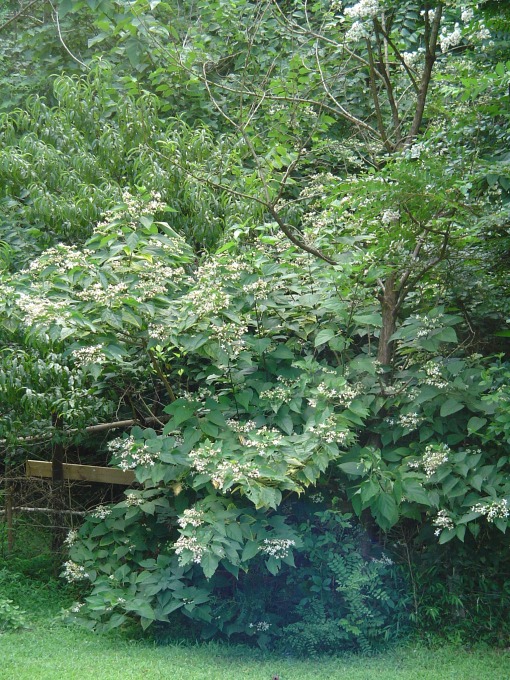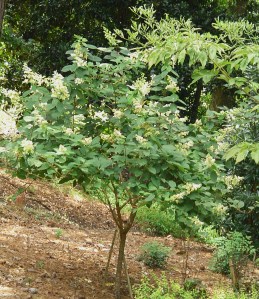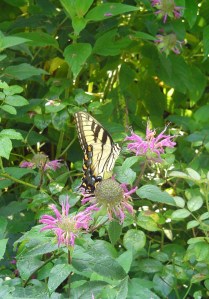What a wonderful sensation to wander out into the butterfly garden and stand in the midst of dozens of butterflies flying around from flower to flower sipping nectar.
Sometimes four or five butterflies are all drinking from the same plant, shoulder to shoulder with the bumblebees.
What joy to be a butterfly in July when all of the sweetest and most luscious flowers are blooming, waiting for you to land and drink their nectar.

Butterfly Tree, or Glory Tree, is covered in flowers from July to September. It attracts hordes of butterflies to the garden.
We have caterpillars fattening themselves up, getting ready to create a chrysalis and take a long nap.

A Tobacco Hornworm, Manduca sexta, has devoured the leaves of this pepper plant. It will become a Carolina Sphinx moth.
We also have butterflies dancing in the air with their mates, and later laying eggs.
Mostly , the butterflies fly around enjoying the warm summer days and abundant blossoms.
There is so much nectar to choose from!
More butterfly close up photos here More butterfly and Bumble Bee photos here
If you want to attract butterflies to your garden, simply cultivate plants they enjoy.
These plants are in bloom now, late July, in Zone 7b in coastal Virginia, and attract huge numbers of butterflies:
Trees and Shrubs
Buddleia davidii Butterfly Bush a shrubby bush in which comes in many different cultivars, from small to very tall. Choose from white, red, various shades of purple from light to dark, and pink and yellow or orange mixtures. Tiny flowers grow in long panicles which attract butterflies and hummingbirds. Blooms last from late June into September. Deciduous. Cut back hard in late winter to only a foot or so high to control size and encourage blooming. Blooms only on new wood.
Clerodendrum trichotomum Butterfly Tree is a small tree which attracts huge numbers of butterflies when it is in blooms. Many small white blooms grow together in a large cluster. After they are pollinated, the flowers change into another beautiful flower like construction with the brightly colored berry in the center. Deciduous
Vitex agnus-castus Chaste Tree is a small shrub or tree covered in long panicles of purple flowers. It looks much like butterfly bush, and can be cut back hard in winter to renew growth. Blooms only on new wood.
Lagerstroemia indica Crepe Myrtle is a shrub or tree, depending on the cultivar you choose. It comes in white, lavendar, and various shade of light pink to very dark pink. It is often a multi-stemmed tree, sends out numerous suckers, and has beautiful bark. Bloom season lasts from July into September. Prune in winter to remove seed pods, thin, and to control size. Blooms only on new wood. Deciduous.
Hibiscus Syriacus Rose of Sharon Large shrub covered in large single or double flowers mid-June through September.
Hydrangea paniculata Pee Gee Hydrangea is a large shrub which produces large panicles of white, or very light pink or very light green flowers. Loved by butterflies,
Annuals and Perennials
Hibiscus moscheutos Rose Mallow (annual) Huge white, pink, or red flowers open for a few hours each day and attract butterflies, hummingbirds, and bees. Long stems begin growing from an ever expanding clump in late spring, reaching a height up to six feet. Each stem bears a number of buds. Each bud lasts only a day or so, opening and closing with the sun,but the plant blooms over a period of several weeks.
Penta lanceolata (annual) Bright clusters of flowers in white, pink, red, or purple.
Echinacea purpurea Purple Cone Flower (perennial) Butterflies love the native Purple Coneflower. Many hybrid cultivars are available in many different colors and forms. They aren’t as hardy and reliable as the species.
Eutrochium species Joe Pye Weed
provides nectar and also is an important host plant for eggs and caterpillars. Butterflies find this plant irresistible, and each plant will be covered in butterflies in season.
Lantana species (tender perennial)
Bee Balm Monarda species (perennial)
Four O’Clocks Mirabilis jalapa (annual)
Rudbekia species Black Eyed Susans (perennial)
Verbena species, both annual and perennial
Zinnia species (annual)
Host Plants for raising butterflies: Various hard wood trees are favored for laying eggs. Caterpillars like to eat parsley, dill, fennel, Joe Pye Weed, as well as leaves of some trees.
All photos by Woodland Gnome
Related articles
- Butterflies Love Butterfly Bushes (georgiabackyardnature.com)
- Bringing Birds To the Garden (forestgardenblog.wordpress.com)
- Butterfly Close Ups (forestgardenblog.wordpress.com)
- Pass Along Plants, Ginger Lily (forestgardenblog.wordpress.com)
- Visiting Friends (forestgardenblog.wordpress.com)
- Late Summer Purple Haze (forestgardenblog.wordpress.com)
- Goldenrod (forestgardenblog.wordpress.com)
- Start planting now for next year’s garden (kansascity.com)
- The Plight of the Monarch Butterfly (theblondegardener.com)


























I didn’t see milkweed listed as the only food source for Monarch larvae. Milkweed has not unattractive red and yellow flowers for your betterfly garden as well. And, milkweed is inexpensive and plentiful.
Pingback: Butterfly Bush | Find Me A Cure
Pingback: Late Summer Purple Haze | Forest Garden